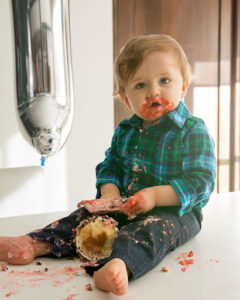
Ever wonder why most of us have a baby photo with food all over our hands and faces? An important part of processing our world is through touch, even from a young age. Our sense of touch gives us information about our environment and the characteristics of our surroundings. We are able to determine if something is hot, cold, sticky, dry, soft, smooth, and so on! Messy play is a vital part of child development as our touch processing feeds into our skills such as motor planning, body awareness, visual-motor skills, fine motor skills, and more. At the moment with our schools and businesses closed many of us may be stuck indoors as we quarantine at home. While our current focus might be keeping our hands and homes clean, we can find ways to continue promoting our tactile sensory processing and get messy safely!
Our sensory processing abilities determine how we respond to tactile input. Your child may demonstrate sensitivity or avoidance to tactile input, such as withdrawing their hands when they get messy or splaying their fingers outward when they engage with wet textures. Maybe your child craves tactile input and you have a hard time keeping their hands clean or to themselves. Either way, incorporating messy play or multi-sensory experiences into their day can help them learn to process and respond to tactile input in order to better participate in grooming, meal time, bath time, and other daily routines!
Sensory Materials from Home:
You can always try to repurpose materials that you already have in your home to promote messy play. Try filling up a plastic bin at home with any of the following. You can switch out the material weekly to continue providing a range of tactile sensory experiences.
- Cotton balls or pom poms
- Feathers
- Dried foods: pasta, rice, beans, oats, corn, seeds, coffee beans
- Wet media: shaving cream, frosting, whipped cream
- Slime, Gak, Flarp
- Kinetic sand
- Beach sand
- Potting soil
- Beads
- Small rocks
- Shredded paper
- Water with ice cubes
- Packing peanuts
Messy Play Activities at Home:
- Have your child help you cook or bake
- Roll dough, wash vegetables, mix batter
- Art
- Finger paint! Paint your child’s hand and make hand prints on paper
- If your child has a hard time using their fingers use cotton balls, Q-tip, or a paint brush
- Use halved apples, peppers, or celery to make vegetable stamps with paint
- Homemade PlayDoh
- Add essential oils for a multi-sensory experience
- Hide puzzles or activities inside of a sensory bin
- Make a mess with shaving cream in the tub during bath time
- Practice letter formation in wet messy play such as whipped cream
- Have your child help you garden by planting seeds or flowers in soil
- Have your child wash their toys in soapy water
- Hide beads inside of Theraputty or PlayDoh
- Play barefoot in grass or sand
- Blow bubbles and encourage your child to pop them with their fingers or toes
- Make spaghetti or pasta and color with food coloring for edible messy play
- Make clough dough or moon sand at home
- Make homemade gak or slime
- Go on a nature hunt and collect leaves, sticks, rocks for a nature sensory bin
Make messy play part of your child’s daily routine by adding it to their sensory diet activities or designating a day for messy food play at meal time. Increasing your child’s experience with messy play will help them learn how to process and respond to tactile input and tolerate a variety of textures and materials. It can also be a motivating way to engage children when you are stuck indoors.
Questions or concerns?
If you have questions or concerns about your child’s responses to tactile or sensory input, please contact us at info@playworkschicago.com or 773-332-9439.
Robyn Geist, MS, OTR/L
Occupational Therapist
Photo Credit: JBryson via istockphoto.com








